Guide To Oil Terminals – Everything You Wanted To Know
Oil is an essential commodity that ensures industries function, vehicles run, and power for human needs is generated. Oil reserves are only found in certain countries that export crude oil and other petrochemical products across the globe.
The preferred means of oil transport is by sea, followed by rail.
Once an oil carrier reaches a port, where does it discharge its cargo?
How is the location for storage sites determined?
What are the precautions in place to prevent accidents?
Who are the major global players in storing and handling oil?
Let’s take a look at the answers to all these questions
In this article, we will take an in-depth look at these structures that play a vital role in the global oil supply chain.
From construction and setting up, to the numerous facilities present on site, this is your go-to article on anything related to oil terminals.

What are Oil Terminals Used for?
Briefly put, oil terminals are storage depots for oil, other fuels, and petrochemical products.
They are most commonly found at ports and other harbour facilities to handle incoming oil products. These can be either from inland oil sources that transport fuels via pipelines, or from ships and oil tankers that berth at a port.
For the former, these pipelines present a cheap method of bringing in oil for export to the ports. From there, they are consolidated and regularly used to replenish outbound tankers (LNG, oil, OBO carriers). They also supply the fuel that is used to run these ships.
Most ports these days provide refuelling capacities within reasonable rates. In the case of oil-rich nations such as those in the Middle East and Western Asia, a portion of the inland supplies is kept aside for this. As carriers are charged for the fuel, the country recovers these costs.
In the case of inbound ships and carriers, the oil is used to fulfil the needs of the country. Such nations have little to no oil reserves and depend on oil-rich nations for power generation and essential operations.
At such ports, the oil is pumped in from ships and separated into 2 categories of storage silos.
A small portion is used to refuel vessels at the port, while the rest is carried inland to oil depots for further division via pipelines.
The use of oil terminals is not restricted to ports and other maritime harbours. Any industry that involves the use of oil or fuel from a stored depot also utilizes an oil terminal.
The exact terminology may vary in these situations. However, they refer to the same design principles and safety standards.
As a general rule of thumb:
1. Oil Terminal – Portside or harbour facility
2. Tank Farm – Multiple silos or containerized units storing oil inland (term “farm” indicating several units at a consolidated location)
3. Oil Depot – Inland storage site for oil
For instance, the air transport industry uses fuel and oil stored in oil depots within the airport premises. Such units are known as air-fuel depots from which road tankers refill aircraft fuel supplies.
Petrol and diesel bunks used to fill up cars and other road transport vehicles also use oil depots (underground terminals) for storage purposes.
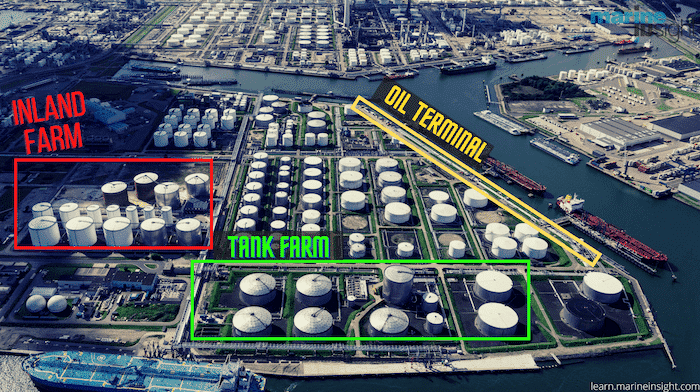
Owning and Setting up Oil Terminals
Owning and setting up an oil terminal is very expensive and technical.
Due to the several factors that come into play when building a terminal, only experienced professionals can undertake this.
The classes of ownership that apply to conventional oil terminals are as follows:
1. Single Owner – For large global players, owning and operating their own depots is a more feasible option. Companies such as Shell and Exxon supply oil to their various facilities from these terminals.
2. Consortium – A consortium is a group of companies that work together for certain benefits. This includes technology and knowledge exchange, expertise, shared operational costs etc. It is the preferred mode of ownership for smaller petroleum companies that cannot venture into constructing a facility by themselves.
3. Independent Facility – In some cases, a private 3rd party may start their own oil storage terminal and supply operations. They hold oil reserves for several companies at a time and charge them for the storage and operational costs. One such company is the Royal Vopak, based out the Netherlands.
4. Military Owned – These use separate oil supplies and terminals from commercial uses for security reasons. The facilities and operations are the same as other terminals, however, the fighter aircraft or warship fuel will be customized for the engine and specifications of the craft.
Setting up a terminal:
Setting up a terminal involves the following steps:
1. Feasibility study to determine the necessity for setting up
2. Location study
3. Design brief and in-depth analysis
4. Manufacturing and construction of the terminal
5. Testing and safety standards
The feasibility study is conducted by consultants from established oil companies. They are usually contracted to determine what model of ownership the firm must go for, the other companies to partner with, and whether constructing an oil depot is necessary in the first place.
The location study plays a major role in the future of the company. It identifies the optimum region in which the operational costs are minimized while also provided a large servicing area.
Proximity to other facilities is also an important factor. A sufficient distance from cities is mandatory, such that the worst-case blast radius falls within the permissible zone.
The design brief and document outline how exactly the project will be undertaken. This includes details of the manpower and equipment required, location studies, the software to be used, protocols to be followed during design, and lastly the step-by-step construction process.
Post-construction, testing must be carried out to ensure that the oil terminal is operating at maximum efficiency and safety.
Considering the large volume of oil stored within, there is a very high chance that an accidental spark could cause a large-scale explosion.
The testing process is a detailed step which can take anywhere from a few days to several months to complete.
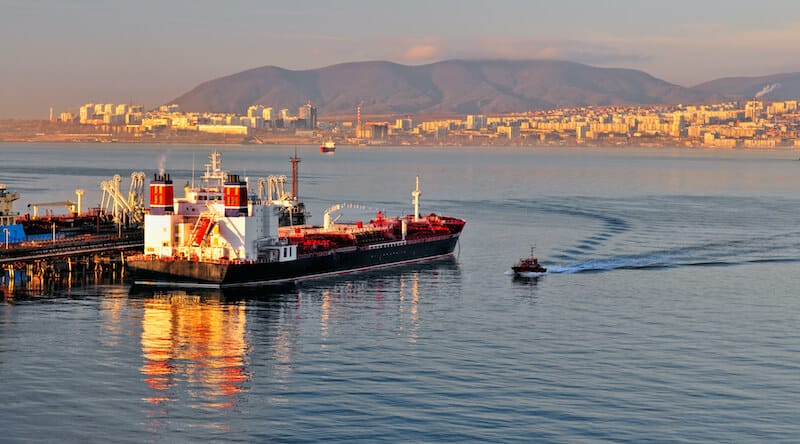
Facilities and Operations at Oil Terminals
Since the main objective of oil terminals is the safe storage and handling of oil supplies, the facilities present on site are aimed at this.
Minimum facilities are directed towards the processing or production of oil and other petrochemicals. Sites and terminals at which some form of production is undertaken are known as “enhanced or advanced oil terminals”.
In general, oil terminals can store 2 types of oil depending on the oil-producing or receiving nature of the country. In the case of nations that have oil reserves and export to other regions, the terminals present at ports are built to store crude oil and unprocessed petroleum products.
This is because they export crude oil for later refining. However, certain trade agreements require the refining of oil from the producing nation itself, if the receiver does not have sufficient facilities and technology to adequately and safely refine the imported crude oil.
For instance, China exports pre-processed oil through the thousands of refineries it operates. On the other hand, Russia often exports crude oil that is later processed into bi-products.
In the case of nations that are receiving oil, the crude oil is sent to a refinery first and then stored within the oil terminal. The only processing that happens within the terminal silos is the addition of certain chemicals to stabilize and impart desirable properties to the oil. The majority of the processes is automated to reduce the chance of human error.
The oil terminal is situated in proximity to the wharves or jetties where oil tankers or other carrier vessels berth.
Since most oil carriers have hatch covers and minor cargo for unloading, cranes are provided along the length of the dock. There is equipment to pump the crude oil from the holds, while there are also vapour recovery facilities at some ports.
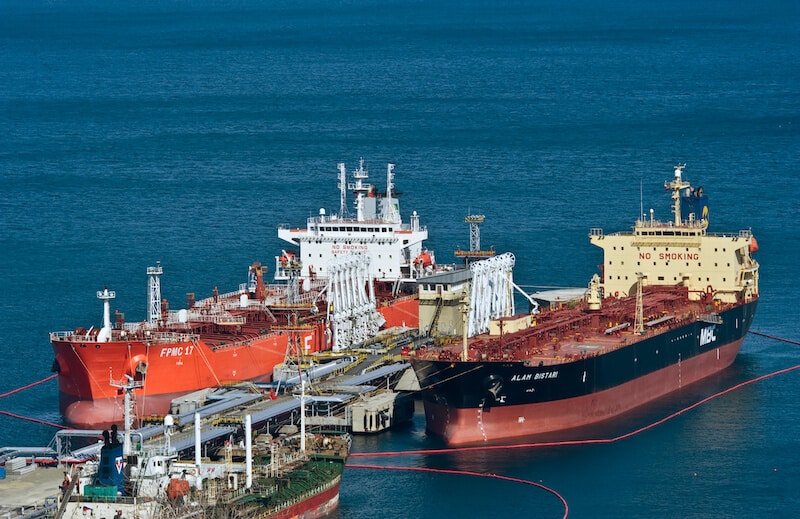
The recovery equipment performs an essential function for the oil industry. Due to the slight offset between the base of each hold and the nozzle from which oil is pumped out, a significant amount of oil is wasted when we consider the millions of tons of petrochemicals transported annually.
To collect the remaining portion of oil that cannot be accessed by the pump, the hold pressure is rapidly decreased until the oil begins to vaporize. Thereafter, pumps are used to vacuum out the vapour, and they are then condensed at designated facilities.
Considering the size of oil tankers, they are generally deep-water vessels that have a significant draft. They cannot dock at most ports due to the limitations on incoming vessel size.
So, offshore sites are selected from where the tanker can safely discharge its cargo. Undersea pipelines then transport the oil to the port where it is stored within the terminal silos.
Location plays a very important role in the setting up of terminals. They must be within close proximity to a refinery (reduces transportation costs) but should also permit the tanker to safely dock.
Lastly, the terminal must be connected to conventional means of transportation (road, rail, coastal, and inland) so that oil from the terminals can easily be rerouted to inland depots.
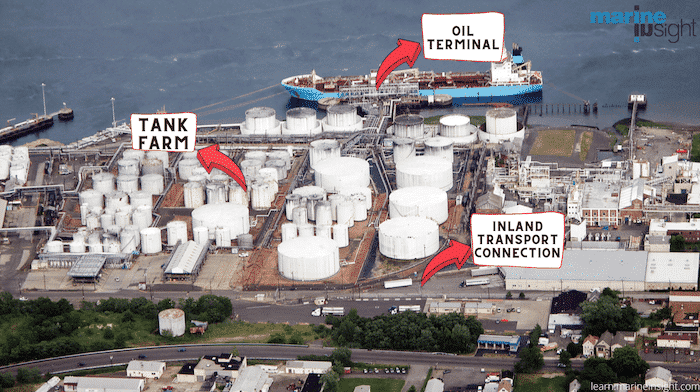
The terminal silos have certain safety features to prevent gas buildup, accidental sparking, overpressure, and leaks. Another provision while building terminal silos is the reduction in vapour losses.
Over time, this can translate to a significant loss in oil. A fixed roof tank is a fully closed storage tank where a conical or hemispherical dome is welded to the cylinder that forms the base of the silo. It can be used to store both liquids and vapours.
A valve known as a “breather valve” is used to relieve pressure buildup within the tank. Only low volatility products are stored within fixed roof tanks, since high volatility substances may quickly vent through the breather valve and reduce the oil content.
Another concept commonly used is the floating roof tank that can be either internal or external. While internal roofs are rare, the external roof is quite common. Unlike fixed roof tanks, the roof of these tanks is floating.
It sits over the liquid, with minimum space for vapour buildup. As the level of oil rises or lowers, the roof also moves to prevent any gap for vapour formation.
However, at very low oil levels, the roof reaches the tank base, where it behaves as a fixed roof tank. To prevent vapour loss from the rim between the roof and shell, a rim seal is placed. There are guides that run vertically down the tank to ensure that the roof remains horizontal at all times.
During the transfer to pipelines or tankers, the oil is warmed to improve flow characteristics. For this, heating coils are placed at regular intervals along the tank side.
Lastly, structures known as “Horton Spheres” are used for storing gaseous products such as LNG, butane, and propane.
These structures are used to prevent stress damage and fatigue caused by support expansion during the warming of compressed gases. It was invented by the Chicago Bridge & Iron Company (CBI) that owns a patent for their design and continues to build Horton spheres for commercial use.
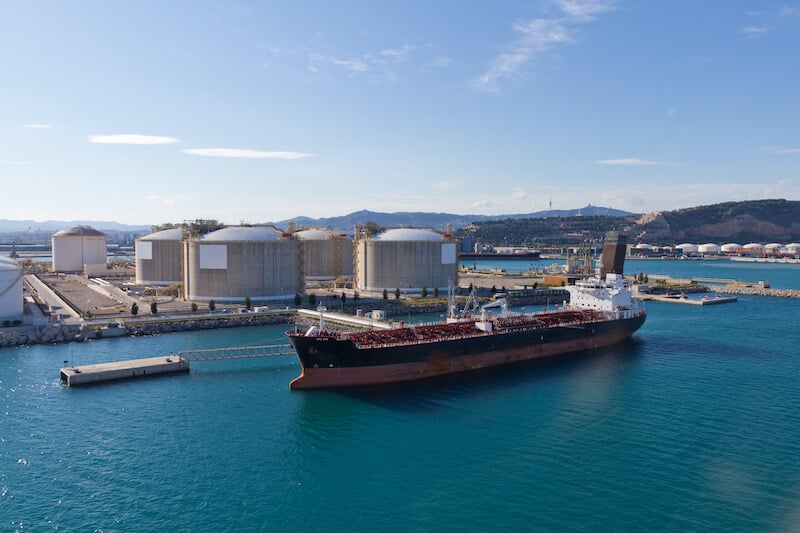
International and Domestic Laws and Safety Standards
Oil terminals are a hotbed for accidental explosions as large supplies of volatile petrochemicals and other products are stored.
Even a small spark near the storage depots can set off a series of explosions that may have dire consequences. To prevent such occurrences, there are numerous international and domestic laws that place restrictions and checks on oil terminals.
There are also standards used by inter-governmental bodies to ensure that the highest quality materials and sufficient safety equipment are used while on site.
The most commonly adopted international standards are as follows:
1. Safety Guidelines and Good Industry Practices for Oil Terminals, United Nations Economic Commission for Europe
2. Environmental, Health, and Safety Guidelines for Crude Oil and Petroleum Product Terminals, World Bank Group
3. Design, Construction, Operation, Maintenance, and Inspection of Terminal and Tank Facilities, American Petroleum Institute
4. Guidance for Oil Terminal Operators, International Maritime Organization, ISPS Code
5. Tank Farm Guidelines for the Chemical Industry, Basle Chemical Industry
6. Design Code for Aboveground Atmospheric Storage Tanks, API
7. Overfill Protection for Storage Tanks in Petroleum Facilities, API RP 2350
8. Prevention of Tank Bottom Leakage – A Guide for The Design and Repair of Foundations and Bottoms of Vertical, Cylindrical, Steel Storage Tanks, Engineering Equipment and Materials Users’ Association
9. Tank Inspection, Repair, Alteration, and Reconstruction, API 653
10. Functional safety – Safety instrumented systems for the process industry sector, International Society of Automation
11. Process Safety Management of Highly Hazardous Chemicals standard, Occupational Safety and Health Administration
12. Safety Guidelines and Good Practices for Pipelines, United Nations Economic Commission for Europe
13. OECD Guidance Concerning Chemical Safety in Port Areas, Organization for Economic Co-operation and Development
Top 10 Oil Terminals Around the Globe
Oil terminals are generally owned by a few large conglomerates that operate a majority share of these facilities. The largest players today are concentrated in China while the US and Europe follow behind.
The primary metrics to measure the size of a company dealing in oil terminals is through-
1. Number of oil terminal facilities operational
2. Volume of oil handled per annum
The top 10 oil terminal handling companies are: (courtesy Insights Global)
S No. Company No. of Terminals Oil Capacity (Million CBM)
| S No. | Company | No. of Terminals | Oil Capacity (Million CBM) |
| 1 | Sinopec | 51 | 44.1 |
| 2 | Vopak | 69 | 33.1 |
| 3 | CNPC | 24 | 25.7 |
| 4 | Kinder Morgan | 96 | 21.7 |
| 5 | PetroChina | 34 | 19.8 |
| 6 | Buckeye | 114 | 18.1 |
| 7 | Oiltanking | 73 | 17.6 |
| 8 | Marathon | 99 | 16.7 |
| 9 | Enterprise | 55 | 13.2 |
| 10 | Magellan | 93 | 13.1 |
The companies are ranked by order of the total oil capacity in million cubic meters per annum. The top 10 is led by Sinopec which has a lead of more than 10 million CBMs over its nearest competitor, Vopak.
On the other hand, when we analyze the number of terminals each company operates, Buckeye stands out as a clear leader with Marathon as the nearest competitor.
Most companies are concentrated in China, as can be seen by Sinopec, CNPC, and PetroChina (all in the top 5) with 89.6 million CBMs between them. Vopak and Oiltanking are the main European players with 50.7 million CBMs. Kinder Morgan, Marathon, Buckeye, Enterprise, and Magellan are from the US with 82.8 million CBMs capacity.
Sinopec is the global leader and is majorly owned by the government of the People’s Republic of China (PRC). It runs over 30,000 petrol stations and more than 50% of the Chinese refineries.
With headquarters in Beijing, it has accounted for over € 300 billion in the past financial year.
In Europe, Vopak is ranked 1st and is based out of the Netherlands. Operational since the past 500 years, it is the largest independent oil terminal corporation. It has operations in Europe, China, and the US with an annual turnover of € 1.25 billion in 2018.
The top 10 companies constitute over 220 million CBMs of oil annually and store 21% of the world’s oil reserves.
Incidents and Accidents Involving Oil Terminals
As highlighted above, oil terminals and depots are probable sites of explosions that can have an impact on the surrounding region as well.
To prevent this, it is important to identify possible sources of accidents and then establish efficient procedures to prevent occurrences.
In this section, we will look at a consolidated list of primary causes for oil terminal accidents and the prevention methods.
Causes of Accidents
The primary causes of accidents can be grouped into the following categories:
1. Operational Error
a. Drain valves accidentally left open
b. Overfill
c. SOP not followed
d. Vent closure during loading
e. Tank cars moved during loading
f. High inlet temperature
g. Oil leaks
2. Equipment or Instrument Failure
a. Thermostat failure
b. Oxygen analyzer failure
c. Floating roof malfunction
d. Relief valves accidental opening
e. Heater failure
f. Discharge valve rupture
g. Overheating or supercooling
h. Vent valve failure to open
3. Lightning
a. Poor grounding
b. Rim seal leaks
c. Direct hit
4. Static Electricity
a. Rubber seal cutting
b. Poor grounding
c. Fluid and solid transfer
5. Maintenance Error
a. Sparks
b. Non-explosion proofing
c. Circuit shorting
d. Faulty welding
6. Tank Rupture
a. Poor soldering
b. Shell distortion
c. Poor fabrication
d. Corrosion
e. High-pressure fluid backup
f. Microbe induced material fatigue
7. Piping Leak
a. Low temperatures
b. Leak during oil theft from pipeline
c. Flammable liquid leak
d. Broken propane line
e. Pump leak
8. Miscellaneous causes
a. Auto ignition
b. Runaway reaction
c. Natural calamities
d. Open flame
e. Theft or arson
f. Terrorist attack (more common than other miscellaneous causes)
Accident Prevention Methods
The various types of accident prevention methods used at oil terminals are as follows:
1. Design
a. Following standards and regulations
b. Hazard identification
c. Safe distance from habitation sites
d. Site inspection
2. Maintenance
a. Hot work permit
b. Risk-based inspection
c. Use proper equipment
d. Personal protection equipment
e. Environment monitoring
f. Routine inspections
g. Ventilation
3. Equipment
a. Pressure retaining
b. Corrosion resistance
c. Pressure relief systems
d. Vibration control
e. Grounding
4. Workplace
a. Static electricity protection
b. Monitoring and measurements
c. Hazard communication
d. Waste oil and water treatment
5. Operation and management
a. Following appropriate SOP
b. Auto inspections
c. Training and education amongst employees
d. Safety audit
e. Ignition source control
f. Safety regulations
6. Miscellaneous checks
a. Grounding
b. Fire protection
c. Risk assessment
d. Emergency response
Source and reference:
Chang, James & Lin, Cheng-Chung. (2006).
A study of storage tank accidents [Internet].
Journal of Loss Prevention in the Process Industries. 19. 51-59. 10.1016/j.jlp.2005.05.015.
You might also like to read:
- What Are Different Types of Ports For Ships?
- 11 Major Container Terminal Operators In The World
- Top 10 Biggest Ports in the World in 2021
- Top 10 Busiest Ports In The World
- Major Container Ports And Port Operators in the World In 2020
Disclaimer :
The information contained in this website is for general information purposes only. While we endeavour to keep the information up to date and correct, we make no representations or warranties of any kind, express or implied, about the completeness, accuracy, reliability, suitability or availability with respect to the website or the information, products, services, or related graphics contained on the website for any purpose. Any reliance you place on such information is therefore strictly at your own risk.
In no event will we be liable for any loss or damage including without limitation, indirect or consequential loss or damage, or any loss or damage whatsoever arising from loss of data or profits arising out of, or in connection with, the use of this website.
Do you have info to share with us ? Suggest a correction
Disclaimer :
The information contained in this website is for general information purposes only. While we endeavour to keep the information up to date and correct, we make no representations or warranties of any kind, express or implied, about the completeness, accuracy, reliability, suitability or availability with respect to the website or the information, products, services, or related graphics contained on the website for any purpose. Any reliance you place on such information is therefore strictly at your own risk.
In no event will we be liable for any loss or damage including without limitation, indirect or consequential loss or damage, or any loss or damage whatsoever arising from loss of data or profits arising out of, or in connection with, the use of this website.

About Author
Ajay Menon is a graduate of the Indian Institute of Technology, Kharagpur, with an integrated major in Ocean Engineering and Naval Architecture. Besides writing, he balances chess and works out tunes on his keyboard during his free time.
Latest Maritime Knowledge Articles You Would Like:
Subscribe To Our Newsletters
By subscribing, you agree to our Privacy Policy and may receive occasional deal communications; you can unsubscribe anytime.















